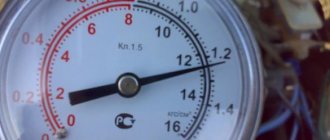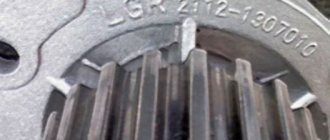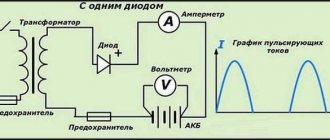Checking the compression of engine cylinders is recommended in almost any instructions when troubleshooting: when the engine has oil, when it stalls under any circumstances, when the car is idling poorly, or simply when its power drops. In many cases, the cause of such problems can be poor compression in the engine, and in order to identify the cause, you need to know what the compression should be specifically in the engine of your car model and how to check this very compression. Compression is the pressure of compressed air in a cylinder at the very end of the compression stroke, when this pressure is maximum.
We decided to write this instruction because measuring compression in cylinders is a very simple task. You will need to measure the compression in each cylinder in turn, while the engine is rotating from the starter drive, but not running on fuel on its own. Then all you have to do is compare the pressure readings in all cylinders with each other and with the pressure indicated in the characteristics of your car (operating instructions or any other reliable source of advanced engine characteristics of your car).
How to check engine compression?
To check, you will definitely need an indispensable attribute of our work - a compression tester, and you will have to buy it at the nearest auto store or simply ask a familiar auto mechanic, a thrifty or avid car enthusiast, or rent it. A compression gauge is a very inexpensive thing and costs a little more than a pressure gauge, although prices for the former vary much more. In general, the cheapest compression meter will cost you 400-1000 rubles, but there are also more professional devices that cost up to 10-15 thousand rubles, but you are unlikely to need them.
When choosing a compression gauge, you need to make sure that its tip is screwed into the spark plug channel (there are those that mercilessly get clogged there), so that the tip and the pressure gauge itself are connected to each other with a flexible hose and not a tube, since in the latter case you may have to remove something else from under the hood, since it will simply get in our way when installing the compression gauge. Also, see that the maximum pressure jackal reaches at least 20 kg/cm2. If the car needs the hands of a master, then use the rental car https://rentamur.ru/ while your car is at the service station.
Compression gauge with adapter attachments for different types of spark plugs
In addition to the compression gauge, you will need an assistant who will turn the starter using the ignition key from the passenger compartment, and a spark plug wrench. Also, your car must have a working starter and, most importantly, an excellent battery condition, since it will have to work quite a lot.
For accurate and correct measurements, you will need to take the following steps:
- First, start the engine and let it run until it reaches normal operating temperature (90º), then turn it off and remove the wires from all spark plugs. When you remove them, mark each wire and its corresponding spark plug with paint (marker, felt-tip pen) of a different color for each spark plug, so as not to confuse them.
- Now you need to prevent fuel from entering the engine. The easiest way to do this is to disconnect the fuel pump from it. Remove the wire plug by grasping the caps without pulling on the wires, which could damage them. Label the test leads if necessary to avoid confusion when putting them in place.
- Clean the areas around the spark plugs to prevent dirt from entering the engine. Unscrew the spark plugs using a socket or a special spark plug wrench.
- Each compression tester has a pressure relief valve - be sure to reset the tester before testing each subsequent cylinder. Screw the tip of the compression gauge into the first spark plug hole.
- Have a helper depress the accelerator pedal all the way to open the throttle fully and begin cranking the starter by turning the ignition key for about 6-10 seconds. At this time, the pressure in the compression gauge will rise with each engine revolution and reach a certain maximum level - then it is necessary to turn off the starter.
- Be sure to record the result of the cylinder compression test. You need to record what compression was obtained as a result of the compression test and approximately how long it took in seconds to reach the maximum pressure on the pressure gauge.
- Check all other cylinders in the same way, also recording the compression readings in the engine on a piece of paper.
The procedure for connecting a compression gauge to check compression in the engine: remove the high-voltage wires from the spark plugs; unscrew all the spark plugs; screw in a compression gauge instead of spark plugs one by one
The compression rate for each engine is different, but in general it is considered normal for a gasoline engine to be about 10-12 kg/cm2. However, check this information for your vehicle model and specification.
We recommend: Do-it-yourself valve grinding when repairing the engine head
If any cylinder has lost compression
If one or more cylinders give a compression reading that is significantly lower than the others, we will need to perform additional testing to determine whether the low compression is due to leakage from worn piston rings or other microscopic holes or cracks in the piston. cylinder.
- Pour a tablespoon (about 10 ml) of clean engine oil into the suspected cylinder.
- Connect the compression gauge and, according to the above instructions, crank the engine again.
- If this results in a noticeable increase in engine pressure, it most likely means that the piston rings are worn out or there is some other air leak in the cylinder, and you will need to go to a mechanic. The fact is that with such a leak, engine oil will rush to the leak site, and, once there, clog it and prevent air from escaping.
- If the compression readings have not changed during the test, then most likely the leak is so large that the engine oil simply failed to “seal” it. This could be due to engine valves or severely leaky gaskets.
To check the valves, the cylinder head must be removed, and this is also not an easy procedure. A leaky gasket, however, will show symptoms other than loss of compression. A leak between the cylinders will cause the engine to run rough, and there may also be a loss of coolant into the crankcase, which will show up as a white emulsifying foreign fluid on the oil dipstick and an overall high oil level.
Table: compression deviations and possible engine malfunctions
| Compression in the engine, kg/cm2 (with the gas pedal fully depressed/throttle open) | Possible malfunction | Possible additional symptoms |
| 12-15 | (Increased compression) Carbon deposits in the combustion chamber of the cylinders due to worn oil seals | Blue exhaust gases and increased oil consumption |
| 10-12 | Normal compression | — |
| 6,5-9,5 | The piston rings or pistons themselves are worn, there is damage to the cylinder walls | Blue exhaust gases and increased oil consumption |
| 7-8,5 | There is damage to the camshaft cam, which may cause the valve to open/close incorrectly | Complete or partial failure of the cylinder |
| 6-8 | The piston bridge has cracked | Blue exhaust gases, increased oil consumption, increased oil pressure |
| 5-8 | Failure to return the valve to its original position | Complete or partial failure of the cylinder |
| 4,5-6 | The piston overheated and burned out | Unstable engine operation at idle, increased oil consumption |
How to check it yourself
Having a compression gauge and an assistant at hand, measuring compression will not be difficult.
- Warm up the engine to operating temperature.
- Shut off the fuel supply to the cylinders. For carburetor engines, disconnect the hose that goes from the carburetor to the fuel pump; for injection engines, remove the fuel pump fuse and let the engine run until the fuel is used up from the system.
- Disconnect all high voltage wires from the spark plugs.
- Unscrew the first spark plug and insert the compression gauge fitting in its place.
- Have a helper run the starter for a few seconds until the pressure gauge needle stops moving up.
- Take pressure gauge readings and compare them with standard values.
- Carry out the same procedure for all cylinders. Compare the compression ratios in the cylinders.
How to measure compression?
According to automotive industry experts, the procedure for measuring pressure should be carried out at least 3-4 thousand kilometers. This is relevant for domestically produced vehicles, since compression problems are much more common in such cars. As for foreign cars, the pressure can be measured once every 10, or even 20 thousand kilometers. If you are sure that something is wrong with your engine, then the pressure should be measured both with the throttle valve open and closed, this is the only way to get accurate readings.
Many motorists know that measuring compression is an important step in car maintenance. How to check compression in cylinders on a diesel or gasoline engine? What device is needed for this? How to measure compression at home? We will talk about this further.
Measurement with a conventional compression meter
To correctly check the compression in the cylinders using a conventional instrument, please note that this procedure is not carried out on a cold engine. The car needs to be warmed up to operating temperature, since you will not achieve the correct performance with a cold engine. When the engine is warm, you should turn off the ignition, and in order to obtain more accurate readings, you need to keep in mind that the battery must be fully charged. Otherwise, the starter may not be spun up to full power, and accordingly, the indicators may be distorted.
Rotary compression meter for measuring pressure
The starter must be in good working order, otherwise you will not get accurate readings.
So, how is compression measured using a conventional device - a compression meter:
- When the engine is warm, open the hood and remove the spark plug wires from the connectors.
- After this, use a spark plug wrench to remove the spark plugs; you need to unscrew them. During this procedure, carefully ensure that the spark plug holes are clean, as they should be free of dirt and debris. If necessary, clean them from dust, but be careful so that dirt does not get inside.
- Place the gearbox selector in the neutral speed position.
- Now take your device and screw its meter into one of the spark plug holes.
- Then you may need the help of another person. The pedal must be depressed and then the starter must be turned on. In this case, the crankshaft must be rotated at least 8 compression strokes.
- At this time, the needle on the device will rise. These actions are repeated until the arrow stops rising. When the pedal is depressed, the throttle valve opens.
- You will be given certain metrics to record. They must be reset after each measurement. As you understand, compression measurements should be carried out on each cylinder.
- After the process is completed, we recommend performing this procedure again for each cylinder, only the throttle valve must be closed. This means that the assistant no longer needs to press the pedal. The obtained indicators must be compared with those established by the automaker specifically for your car, and mileage should also be taken into account.
Checking with a compression gauge
To measure the pressure in the engine cylinders, it is necessary to use a special tool - a compression gauge. The cost of such a device is low, so any car owner can purchase it. In addition to it, you will need a spark plug wrench and an assistant - he will have the important task of rotating the starter using the ignition key.
- The machine warms up to operating temperature.
- Carefully unscrew all spark plugs.
- The throttle valve opens, that is, the assistant presses the accelerator pedal all the way, while simultaneously turning the ignition key and thereby setting the starter in motion.
- The compression tester plug is tightly inserted into the spark plug well. The starter starts and the engine “cranks” for two to three seconds - this time is enough for the pressure gauge readings to stop increasing.
- The starter stops and the measurement data is recorded. Compression is measured in all engine cylinders.
- The compression gauge is completely emptied of air before each subsequent measurement. If the results obtained deviate from the norm, the readings are taken again.
Measuring engine compression using a compression meter video:
Compression values measured in different cylinders should be about 10% of the maximum pressure value indicated on the instrument scale. A decrease in results below 15% of the maximum indicates wear of parts - piston, valves, piston rings or cylinder. Operating a car engine in this condition risks its complete failure, major repairs, or complete replacement in the future.
The main difference between the process of measuring compression on an injector and a carburetor is the mandatory disconnection or removal of the crankshaft sensor. Experts advise doing this in order to protect the ECU from damage and completely shut off the fuel supply.
What is compression?
This is the pressure (not to be confused with arterial pressure) created by the piston at the end of the compression stroke. But not the compression ratio - the difference in the volumes of the cylinder space under opposite states of the piston or a dimensionless coefficient. The compression ratio is an almost unchanged indicator; it changes only after tuning the internal combustion engine or boring the cylinders.
Compression is the pressure created by the engine pistons when the crankshaft rotates with the flywheel at 200-300 rpm. As the piston group wears out, the indicator changes. Therefore, it is used for accurate diagnostics of an internal combustion engine. It is measured in bars, megapixels, kgf/cm2. But, more often it is measured in atmospheres. To find the problem area, the value is recorded in all cylinders and then compared with the optimal value.
How often should compression ratio be measured?
The exact frequency of checking compression of power units has not been established. There are symptoms that indicate the need for measurements:
- one or two cylinders are not working well, causing the engine to shake and “trouble” even at idle;
- there was a significant consumption of engine oil (over 100 g per 1 thousand kilometers);
- engine power has dropped;
- bluish or white smoke comes out of the exhaust pipe;
- Cold starting is difficult.
If you are used to checking and changing spark plugs every 20-50 thousand kilometers, then measure the pressure in the cylinders at the same frequency. This will help monitor the condition of the CPG and prepare in advance for possible repairs.
How to correctly measure compression on a gasoline unit
Before measuring pressure, you should perform the following steps:
- Warm up the engine.
- Remove the high-voltage wires from the spark plugs and put them aside. In some imported car models, you will have to remove the ignition coils to gain access to the spark plugs.
- In older cars with a carburetor, you need to disconnect the switch connector.
- Stop fuel supply. On carburetor versions this is done by removing the hose going to the mechanical fuel pump. The electric pump that powers the injection motor should be de-energized by removing the corresponding fuse.
- Unscrew the spark plugs and wipe the seat sockets.
Pressure measurement starts from the first cylinder
Measurements are taken in each cylinder in turn. The inspector screws in the tip of the device and gives a command to the assistant, who turns on the starter by pressing the accelerator pedal all the way. When the pressure gauge needle begins to fluctuate in one place, you need to turn off the ignition and record the readings. After which you can move on to the next cylinder.
1.4 MPa is an excellent compression indicator for a gasoline engine
How to measure compression: video
How to determine the pressure in diesel cylinders
To organize the procedure, you will need to prepare a well-charged battery and a compression gauge for working with diesel engines (it has special attachments and a measurement limit of up to 60-70 atmospheres). Engine compression is measured after it has warmed up. Following actions:
- remove the glow plug;
- screw the compression gauge into the vacated hole;
- turn off the diesel fuel supply (remove the power plug from the solenoid valve);
- ask a friend to press the accelerator (if the diesel engine has a valve that creates a vacuum used in the vacuum brake booster and regulator) and turn on the starter with the “start” button;
- remember (write down) the data obtained using the device;
- check the obtained values with those recommended by the car manufacturer (the necessary information is in the service book).
We recommend: DIY installation of xenon and bi-xenon lenses in headlights
The compression value in a diesel engine depends on the brand of engine and is in the range of 28-40 kg/sq.m. see. An interesting dependence of compression in a diesel engine on the possibility of starting it at a certain outside temperature. Below are the compression values when the engine starts without problems:
- up to 28 kg/sq. cm: air temperature not lower than minus 15 degrees;
- up to 30 kg/sq. cm: normal start at minus 20;
- up to 32 kg/sq. cm: the engine will start at minus 25;
- up to 36 kg/sq. cm: start-up can be done at minus 30;
- up to 40 kg/sq. cm: diesel is able to start at 35 degrees below zero.
A drop in compression in diesel engines is accompanied by the appearance of a bluish exhaust from the muffler pipe, which is associated with incomplete combustion of fuel due to low temperature. Another consequence of a decrease in pressure in the cylinders is poor atomization of diesel fuel in the chambers, leading to a drop in power of the power unit.
Compression standards in engine cylinders
To assess the technical condition of the power unit, you need to know what compression values are considered normal, because engines are different. As a result of repeated practical measurements made over many years, the following relationship between the compression ratio and the measured pressure was revealed: when taking measurements on a car with a hot engine, a working starter and a fully charged battery, the minimum permissible compression value is equal to the nameplate compression ratio multiplied by a factor of 1 ,3.
In numbers for different engines this is expressed as follows:
| engine's type | Gasoline, old model with compression ratio up to 8.5 | Modern gasoline with a compression ratio of 9.3—10 | Diesel |
| Minimum permissible pressure, Bar | 11 | 12 | 22 |
| Optimal pressure, bar | 13 | 14—15 | 30 |
When the piston group of a car is severely worn out or the valves are burnt out, the compression in the “sick” cylinders drops below the permissible values indicated in the table. If, for various reasons, a large amount of motor lubricant gets into the CPG, then all the gaps become sealed, and the pressure rises above normal. This phenomenon can mislead an inexperienced motorist who undertakes diagnostics.
A difference in cylinder performance exceeding 1 bar is also unacceptable. It indicates that one or more components of the CPG are not operating at full capacity, or are even inactive, increasing fuel consumption by 10-25%.
Compressometer - a device for measuring pressure with your own hands
Measurements are carried out with a special device - a compression meter, consisting of the following elements:
- pressure gauge with threaded fitting;
- steel tube or flexible hose with built-in check valve and air release button;
- a nozzle for screwing into a cylinder, equipped with adapters for other threads or a rubber cone.
Compression gauge complete with various attachments and adapters
The pressure gauge is screwed into a tube (flexible hose), and a threaded tip is installed at the other end. The check valve serves to record the pressure gauge readings, because when checking, the piston “pumps up” pressure over several revolutions of the crankshaft (about 10).
To analyze power units running on gasoline and diesel fuel, pressure gauges with different measuring scales can be used. If for gasoline engines a device designed for 20-25 Bar is sufficient, then for diagnosing a diesel engine a scale of at least 50 Bar is required.
How and what to measure
Compressometer
Compression is measured with a special device - a compression meter. It is a pressure gauge with a hose, at the end of which there is a fitting, either metal with a thread for a spark plug hole, or rubber in the form of a cone.
The process of measuring compression using a compression gauge involves placing a fitting in the spark plug hole and cranking the crankshaft with the starter until maximum pressure is reached.
Compression in a cylinder can also not be measured, but checked and compared with other cylinders.
To do this, unscrew all the spark plugs except one, and manually (using a wrench on the generator pulley nut) turn the crankshaft until the piston reaches top dead center.
Then they check the second cylinder, the third and the fourth in the same way, and compare the applied forces. Of course, this method is not comparable to measuring with a compression gauge, but it can help to understand which cylinder has a problem.
What should the compression be in VAZ cars?
The average compression rate for unboosted VAZ engines is 8-9 atmospheres, for forced ones with a reduced combustion chamber - 11-13 atmospheres.
In order to accurately determine the standard compression ratio, use the table that indicates the compression ratio in the cylinders of eight- and sixteen-valve VAZ engines.
| Number of valves | 16 | 16 | 8 | |
| Engine volume, l | 1,5 | 1,6 | 1,5 | 1,6 |
| Cylinder diameter/piston stroke, mm | 82/71 | 82/75,6 | 82/71 | 82/75,6 |
| Compression ratio | 10,5 | 10,3 | 9,9 | 9,6 |
Compressometer
ATTENTION! A completely simple way to reduce fuel consumption has been found! Don't believe me? An auto mechanic with 15 years of experience also didn’t believe it until he tried it. And now he saves 35,000 rubles a year on gasoline! Read more"
Measuring compression indicators is best done with a compression meter operating on the principle of a pressure gauge. If the latter measures tire pressure and is designed for light loads, then the compression meter is a more powerful unit. Compare the pressure inside the engine and the tire, and then the difference between the two devices will become visible. However, the principle of their functioning is largely similar.
Today, there are three types of compression meters.
- For gasoline units.
- For diesels.
- A universal option used for diagnosing power units of any car.
In addition to the fact that compression meters come in different types, they also differ in models.
A compression meter is a diagnostic unit that is part of the mandatory tools for maintenance. Experienced motorists use it to analyze the technical condition of the engine without using expensive service stations. A good compression meter allows you to carry out diagnostics yourself, without the help of an assistant, which is also considered a big plus. As soon as I noticed problems with the engine, I took it and checked it.
A prerequisite for a high-quality meter is the presence of a tip on it that allows you to screw the measuring device into the spark plug hole. Without such a threaded output, the measurement accuracy is reduced significantly.
It is also recommended to purchase a meter that is equipped with a compression breather in the tip itself, which is screwed into the spark plug hole. If the valve is located directly below the scale, the readings will be less accurate.
A conventional compression meter is most often used to determine the compression level in garage conditions. However, this measurement can be called uninformative, although it is still possible to clarify the overall picture.
For a more complete diagnosis, it is recommended to carry out the test using special equipment, preferably at a service station. For example, such an installation as the AGC is used to monitor the condition of the CPG. The measurement option is no different from the compression meter, but the AGC helps to measure the vacuum values, not the compression values in the cylinders.
AGC is also used to detect leaks that are associated with the combustion process. The installation helps determine the effectiveness of valve fit, assess the condition of the pistons, and detect coking or stuck rings.
Engine compression: what is it and what is it used for?
Compression, in simple terms, is the pressure generated at the highest point of movement of the crankshaft during the compression stroke. Factors influencing changes in the compression ratio can tell a lot about the condition of the engine, its level of wear and possible problems that affect its normal functioning and the behavior of the car as a whole.
Measuring engine compression using instruments
Such factors include timing defects, wear of the piston group, coking of parts and many others. Deterioration of the technical parameters of the power unit, a sharp jump in fuel consumption - all these are the consequences of changing the compression value up or down, regardless of what specific reasons were the impetus for this.
Pressure is measured in atmospheres. Some pressure gauges use other units of measurement - bar, Megapascal.
Factors affecting internal combustion engine compression
The compression level directly depends on the volume of incoming air flow, which, in turn, depends on the problems and defects listed above. Separately, it is worth mentioning the throttle valve, which has a significant impact on compression in the cylinders: its position is regulated by air flow. Its intensity, in turn, depends on the air filter: drivers often forget to clean and change it when it gets dirty, which leads to a deterioration in its capacity.
A dirty air filter reduces engine compression
We recommend: Replacing valve stem seals for Lada 2107 (VAZ 2107)
Compression values can vary greatly depending on the set gas distribution phases: if errors are made during their installation, the closing moment of the intake valve changes, which moves the cylinder in a certain direction.
The compression ratio can vary depending on the width of the clearances in the valve actuator. For example, the pressure may decrease if the gap is too small, causing the closing of the intake valves to be delayed. At the same time, valve overlap increases - the angle at which the valves open at the same time. This also has a negative impact on compression levels.
Due to the low temperature of the internal combustion engine, the air flow entering a cold engine does not have time to expand and warm up sufficiently, without subsequently creating the required pressure - accordingly, the compression value of the cylinders also drops.
One of the reasons for reduced compression is valve clearances
The presence of valve clearances leads to air leaks. Their intensity is influenced by certain factors that have a similar effect on the amount of compression:
- Motor temperature. As it increases, compression also increases, since the distance between the parts decreases;
- Engine oil supply. A tighter fit of the engine's rubbing parts to each other is ensured by an oil layer on their surface, which also makes it possible to reduce gaps and reduce air leaks through them;
- Fuel supply. The oil film formed on the inner surface of the cylinders when fuel drops enter is quickly washed away, which can stall the operation of the entire internal combustion engine, increases friction and reduces the density of contact of surfaces to each other;
- Depressurization of pressure gauge hoses, check valve, high force applied by springs;
- Increase in crankshaft speed.
What does engine compression affect?
The engine compression level affects various processes and engine parameters:
- Completeness of fuel combustion;
- Engine oil consumption;
- Ease of starting the engine. A decrease in pressure below normal makes it much more difficult to start the engine, especially in the cold season;
- Correct operation of the cylinders. Low compression can increase the risk of engine stalling;
- Power. The lower the compression, the lower the power.
What affects engine compression
- Throttle position . When the throttle is closed or covered, the pressure decreases
- Air filter dirty.
- Incorrect valve timing when the valve closes and opens at the wrong times. This happens when the belt or chain is installed incorrectly.
- The valves do not close on time due to gaps in their drive.
- Motor temperature . The higher its temperature, the higher the temperature of the mixture. Therefore, the pressure is lower.
- Air leak . Air leaks reduce compression. They are caused by damage or natural wear of the combustion chamber seals.
- Oil entering the combustion chamber increases compression.
- If fuel enters in the form of droplets , then compression is reduced - the oil, which plays the role of a sealant, is washed off.
- Lack of tightness in the compression gauge or check valve.
- Crankshaft rotation speed . The higher it is, the higher the compression; there will be no leaks due to depressurization.
The above describes how to measure compression in an internal combustion engine running on gasoline. In the case of a diesel engine, measurements are made differently.
What to do if diagnostic results are disappointing
When the pressure in one or more cylinders deviates from normal, you are dealing with a malfunction of the power unit. As a rule, such problems require partial or major repairs of the “heart” of the machine. If the indicators are too low, the following breakdowns are possible:
- Wear of rings, pistons and liners (with the same values on all cylinders). The “diagnosis” can be clarified if a second measurement is taken with the addition of 4-5 ml of motor oil to the cylinders. Increasing the compression will confirm the result. If the readings do not change, then the following problem occurs.
- The presence of leaky valves in the chambers (at different values).
- One of the valves or pistons is burnt out (no pressure at all).
Piston burnout in the center (left) and side (right)
A pneumatic tester can provide more accurate results. The breakdown is detected as follows: if air goes into the crankcase, then the pistons pass, and if it goes into the manifold, the valves. Malfunctions associated with a drop in compression below normal are eliminated by disassembling the power unit and replacing worn parts. There is no point in changing one valve, since over time the next one will fail. It is better to install a new valve group.
The same applies to pistons - a set is installed at once, and the parts are selected by weight so that the difference is no more than 5 g. Fitting is done by removing a thin layer of metal from the inside of the heaviest pistons with a scraper. If, after removing the block head, the measurement showed a large ellipse-shaped hole in the cylinders, then they should be bored on a machine to the next repair size.
In many foreign-made engines, the installation of repair parts is not provided. There you need to change the entire set at once - liners, pistons and rings.
If you do not respond to a drop in compression below normal in a timely manner, the consequences may be as follows:
- cold starting the engine will become more difficult, and then completely impossible, without injecting oil into the cylinders;
- consumption of motor lubricant due to waste will increase to 1-1.5 liters per 1000 km, which may cause spark plugs to fail and rings to become coked;
- due to the large difference in compression in the cylinders, the engine will operate unstably and vibrate;
- fuel consumption will increase significantly;
- the power of the power unit will drop to such an extent that driving will become impossible.
This is what a burnt valve on the side looks like
The reason for excessive compression is the presence of motor oil in the combustion chambers in large quantities, which leads to compaction of all gaps. The problem arises due to unsuitable oil reflecting caps, when lubricant enters the chambers not from below, but from above, through the valves. This problem is considered relatively harmless: oil deflectors are replaced in 2-3 hours, depending on the make of the car.
Compression measurement continues to be one of the simplest and fastest methods for diagnosing power units. When engine problems occur, the first thing you need to do is check the pressure. And based on the test results, you should decide on the further sequence of actions: carry out more in-depth diagnostics or disassemble and repair the motor.
Checking compression without instruments
It is impossible to measure pressure in cylinders without using special equipment. Despite this, it is possible to establish the fact of its presence, that is, check it without a compression gauge or pressure gauge.
Checking compression without a compression gauge video:
Changes in the behavior of the car, sluggish and unstable operation at low speeds, the appearance of bluish exhaust smoke, oily spark plugs - all this signals poor compression. Its decrease leads to an increase in crankcase gas pressure, contamination of the ventilation system, an increase in Co concentration in the exhaust, and contamination of the fuel combustion chamber.
Hearing test
The simplest and, admittedly, effective way to check for compression. When the starter rotates, each compression stroke is performed with a characteristic sound if the required pressure is present in the cylinders. At the same time, a slight wobble is normal for the motor. The lack of compression is accompanied by almost complete silence - the beats cannot be heard, there is no vibration or shaking. Often the cause of this behavior is a broken timing belt.
Blocking the spark plug well
After unscrewing the candle from the well, the latter is closed with a cork or thick cloth. If there is compression, the plug will fly out of the hole with a characteristic pop. If there is no pressure, then the barrier in the well will remain in its place.
The wells are cleared of candles and covered with cork or cloth.
Applying force to turn the crankshaft
Despite the fact that this method of checking compression is the most inaccurate, it remains one of the most popular. All spark plugs are unscrewed except for the first cylinder and the crankshaft is manually turned until the compression stroke is completed. A similar procedure is carried out with all other cylinders, remembering the force applied each time.
Since all the methods described above for measuring compression are absolutely unreliable, it is best to use a compression meter. The normal compression value for a particular vehicle is indicated in its operating instructions. In the absence of such values in the technical documentation, it is enough to know the compression ratio to determine the compression. It is calculated using the following formula:
compression ratio * K,
where K equals 1.3 for gasoline engines and 1.3–1.7 for diesel internal combustion engines.
Based on the appearance and condition of the spark plugs and exhaust smoke, only a specialist can determine the presence of compression and its approximate value. This method is applicable to old cars with a worn-out engine after the internal combustion engine begins to consume oil in large quantities and has to be topped up frequently, which leads to the appearance of characteristic bluish exhaust smoke. This indicates that oil is entering the fuel combustion chamber.
Blue exhaust smoke is a sign of oil entering the combustion chamber and reducing compression
We recommend: How to check current leakage on a car with a multimeter
When compression is measured on a cold engine
Problems with starting the power unit force you to check the compression level “cold”, that is, without preheating the car.
In the case of a gasoline internal combustion engine, the compression level when checking “cold” should be two times lower than the norm and range from 4.5 to 5.5 atmospheres. This difference is explained by the fact that the rings lie in the pistons - this is a malfunction that requires prompt elimination.
The diesel engine does not start when its compression drops below 17 atmospheres. If the pressure exceeds 24 atmospheres, then it’s time for the engine to undergo major repairs. The compression of a diesel power unit is checked after all the oil has been drained - this is the only way to obtain reliable and real measurement results.
Measuring pressure on a removed engine
It is difficult to check compression with a removed engine, but it is possible. This is done mainly when a motor is purchased separately, and hand-held - a check allows you to verify, albeit indirectly, that it is in good working order. In order to determine the compression, starting the engine is not enough - you need to install and secure it correctly. The best option is to connect the necessary wiring to it, connect the starter, fuel pump and battery. If the starter is started only through the gearbox, which is typical for cars with front-wheel drive, you will have to suffer and connect the gearbox as well. Only after this will it be possible to obtain more or less accurate compression indicators.
Checking the compression indicators of a non-dismantled engine
You can, of course, make everything much simpler: crank the crankshaft to top dead center, having previously connected a pressure gauge to the engine and determined the readings from it. True, such values will be “cold” measurements and will differ greatly from the actual compression values.
We evaluate the results obtained
If the pressure indicator in the cylinders varies slightly (dispersion of indicators within one atmosphere), then most likely this indicates that the cylinder-piston group is in good condition.
Sometimes the compression gauge shows higher pressure in a particular cylinder than in the others. This indicates a malfunction in this unit. For example, the oil scraper ring allows a certain amount of oil to pass through, which “masks” the problem. In this case, oil deposits will be noticeable on the electrode of the spark plug (you can read about other types of deposits on spark plugs here).
Some motorists take compression measurements on the engine of a car, motorcycle or walk-behind tractor to calculate the time remaining before a major overhaul of the power unit. In fact, this procedure is not so informative.
The relative error of such a diagnosis is too great for the compression indicator to be the main parameter that allows us to establish the exact state of the CPG. Compression is affected by many additional factors mentioned at the beginning of the article. Normal pressure does not always indicate that the CPG is normal.
Waters is one example. A car with high mileage. The engine is carburetor, the compression in it is about 1.2 MPa. This is the norm for a new engine. At the same time, oil consumption reaches two liters per 1,000 kilometers. This example demonstrates that compression measurements are not a “panacea” for solving all engine problems. Rather, it is one of the procedures that is included in a complete engine diagnosis.
As you can see, you can check the compression in the cylinders yourself. However, this will help in determining whether the car really needs to be taken to a mechanic. Only professionals can carry out competent diagnostics of the engine and determine which part needs to be changed.
Equipment for self-measurement: compression meter and AGC
Engine compression measurements are carried out to identify indirect engine malfunctions. The following tools are used for accurate diagnosis:
- Compressometer;
- Compressograph;
- Cylinder leakage analyzer.
Compressometer
It allows you to conduct a budget check of the condition of the central heating plant. The cheap model costs around $11. It will be enough for several measurements. The more expensive version costs about $25. Its kit most often includes several adapters with hoses of different lengths.
It is worth paying attention to the fact that the device can be with a threaded fastener, or it can be pressed. In the first case, it is screwed into the spark plug hole, which makes the procedure easier and more accurate (small leaks are eliminated). The rubber bushing of the second type of device must be pressed tightly against the hole in the spark plug well.
This device is a regular pressure gauge with a check valve, which allows you not only to see the indicator, but also to record it for a while. It is advisable that the check valve be separate, and not be content with the one with which the pressure gauge is equipped. In this case, the measurement accuracy will be higher.
There are also electronic compression gauges. This is a motor tester that allows you to measure not only the pressure in the cylinder, but also changes in the current on the starter during the “idle” cranking of the engine. Such devices are used at professional service stations for in-depth vehicle diagnostics.
Compressograph
This is a more expensive version of the compression meter, which not only measures the pressure in an individual cylinder, but also creates a graphical report for each component. This device belongs to the category of professional equipment. Its cost is about 300 dollars.
Cylinder Leakage Analyzer
This device does not measure the compression itself, but the vacuum in the cylinder. It allows you to assess the condition:
- cylinders;
- pistons;
- piston rings;
- intake and exhaust valves;
- valve stem seals (or valve seals);
- sleeves (their wear);
- piston rings (their coking);
- timing valves.
The tool allows you to measure indicators without disassembling the engine.
For self-checking at home, a budget compression meter is sufficient. If it shows a low result, then you should contact a service station so that specialists can identify the problem and carry out the necessary repairs.
Compression test cold or hot
Measurements of compression of a diesel engine are carried out somewhat differently, since this power unit operates on a different principle (mixing of air and fuel occurs immediately at the moment of injection of diesel fuel into the chamber, and due to the strong compression of the air, this mixture spontaneously ignites). By the way, since the air in the cylinders of a diesel engine must be heated from compression, the compression in such an engine will be higher than that of its gasoline counterpart.
First, in a diesel engine, the valve that opens the fuel supply is turned off. The fuel supply can also be shut off by holding the shut-off lever installed on the fuel injection pump. To determine the compression in such an engine, a special compression meter is used. Many diesel models do not have a throttle valve, so there is no need to press the accelerator pedal while taking measurements. If the car does have a damper installed, it must be cleaned before taking measurements.
Based on the results, the condition of the cylinder-piston group of the unit is determined. Moreover, it is necessary to pay more attention to the difference between the performance of individual cylinders than to the average compression value in the entire engine. The degree of wear of the CPG is also determined taking into account the oil temperature in the internal combustion engine, incoming air, crankshaft rotation speed and other parameters.
An important condition that should be taken into account when measuring compression, regardless of the type of power unit, is warming up the engine. Before connecting the compression gauge to the cylinders, it is necessary to bring the internal combustion engine to operating temperature. This will ensure proper oil pressure, as when the car is moving. Basically, the desired temperature indicator is achieved at the moment when the cooling system fan turns on (in case the engine thermometer scale does not have numbers, but only divisions).
On a gasoline engine, just as in the case of a diesel engine, it is necessary to shut off the fuel supply. This can be done by turning off the power to the fuel pump (this applies to injectors). If the car has a carburetor, then the fuel hose is disconnected from the carburetor and the free edge is lowered into an empty container. The reason for this procedure is that the fuel pump in such a car is mechanically driven and will pump gasoline. Before connecting the compression gauge, it is necessary to burn all the fuel from the carburetor (let the car run until the engine stalls).
Next, ALL ignition coils are unscrewed (if the car uses individual ignition coils for each cylinder). If this is not done, then during the procedure they will simply burn out. Also, ALL spark plugs are removed from the cylinders. A compression gauge is connected to each cylinder in turn. It is necessary to crank the crankshaft several times with the starter (until the pressure on the scale stops increasing). The results are compared with the factory value (this information is indicated in the instructions for the machine).
Among motorists, there are two opposing opinions regarding when to check compression: cold or hot. In this regard, the most accurate indicator will be the measurement taken after the vehicle has been preheated, since in a cold unit there is no oil film between the rings and the cylinder wall. Naturally, in this case, the compression of the internal combustion engine will be less than after warming up. If this “disadvantage” is eliminated, then when the unit heats up, as a result of the expansion of the rings, the cylinder mirrors will be damaged.
But when the engine does not start at all, it is worth checking the compression when it is cold in order to identify or eliminate problems with the cylinder-piston group. When performing this procedure, it should be taken into account that the measurements are taken cold, so the ideal value should be lower than that specified by the manufacturer.
Another factor to consider, regardless of when the compression is checked, is the battery charge. The starter must provide high-quality rotation of the crankshaft, which can give incorrect results if the battery is weak. If the battery is “living its last days,” then in the process of measuring compression, you can connect a charger to the power source.











